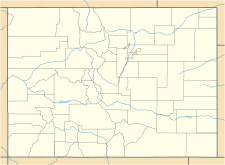Isabelle Glacier facts for kids
Quick facts for kids Isabelle Glacier |
|
|---|---|

Isabelle Glacier as photographed in the 1920s
|
|
| Type | Mountain glacier |
| Location | Boulder County, Colorado, United States |
| Coordinates | 40°03′48″N 105°38′42″W / 40.06333°N 105.64500°W |
| Length | .15 mi (0.24 km) and .30 mi (0.48 km) wide |
| Terminus | Talus/proglacial lake |
| Status | Retreating |
Isabelle Glacier is a cool mountain glacier found in the United States. It's located in the beautiful state of Colorado, specifically in Roosevelt National Forest. This glacier is a special type called an alpine glacier, which means it forms high up in the mountains.
Contents
Discovering Isabelle Glacier
Isabelle Glacier is a natural wonder nestled in the mountains. It's a large, slow-moving river of ice that helps shape the land around it. Glaciers are important because they store a lot of fresh water.
Where is Isabelle Glacier Located?
You can find Isabelle Glacier in Boulder County, Colorado. It sits about .25 mi (0.40 km) southwest of a mountain called Shoshoni Peak. The glacier is also just east of the Continental Divide of the Americas, which is like a giant imaginary line that separates which way rivers flow across North America. On the other side of this divide, you'd find another glacier called Fair Glacier.
How Big is Isabelle Glacier?
Isabelle Glacier might not be the biggest glacier in the world, but it's still impressive! It stretches about .15 mi (0.24 km) long. It's also quite wide, measuring around .30 mi (0.48 km) across. Imagine a football field; this glacier is roughly a quarter of a mile wide!
What Does Isabelle Glacier Do?
This glacier plays a very important role in its environment. It's the main source of water for the South Saint Vrain Creek. This means that as the glacier slowly melts, it feeds fresh, cold water into the creek, which then flows downstream. This water is vital for plants, animals, and even people in the area.
Is Isabelle Glacier Changing?
Like many glaciers around the world, Isabelle Glacier is currently retreating. This means it's getting smaller over time. Scientists study glaciers like Isabelle to understand how our planet's climate is changing. The glacier's end, or terminus, is currently a mix of rocky debris and a lake formed by its melting ice.
Visiting Isabelle Glacier
If you love hiking and exploring nature, you can actually visit Isabelle Glacier! There's a trail that leads right to it. The hike is about 8.4 mi (13.5 km) round-trip from the trailhead. It's a great way to see a real glacier up close and experience the stunning mountain scenery of Colorado.


